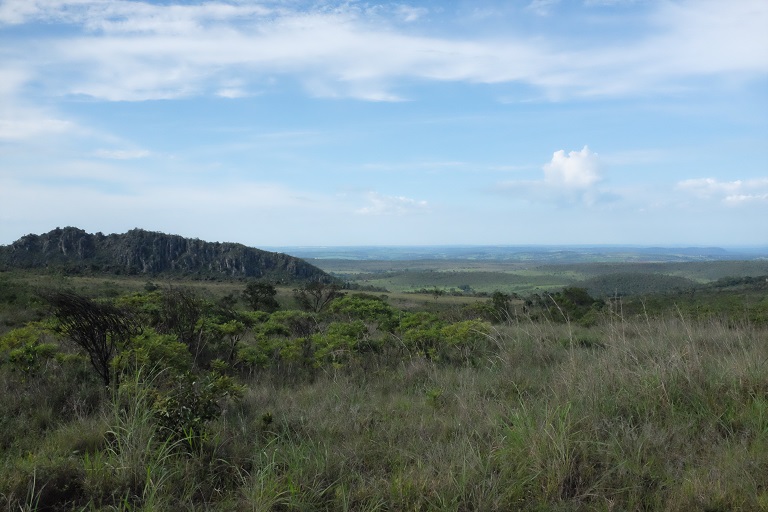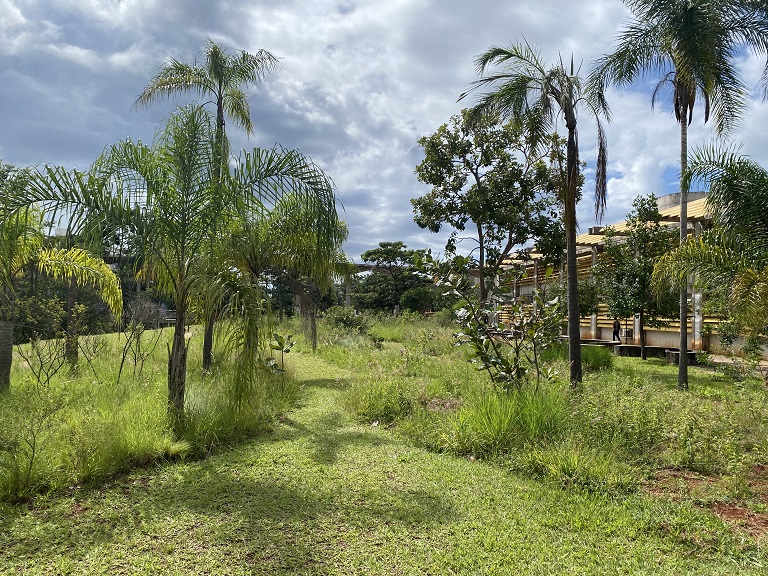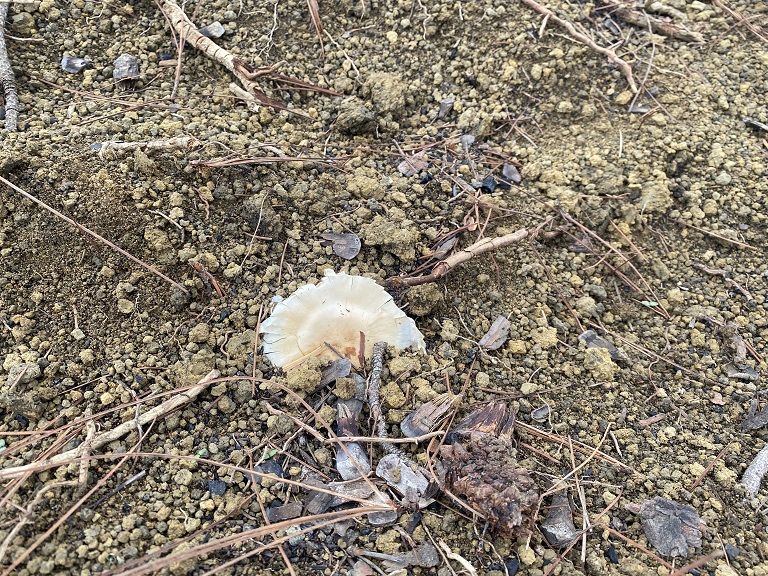- Countries around the world have made ambitious targets to restore native ecosystems as an important nature-based solution, with Brazil committing to restoring 12 million hectares (30 million acres) of native vegetation by 2030.
- While restoration in places like the Amazon has attracted significant funding and resources, non-forested biomes like Brazil’s Cerrado savanna are struggling to attract the same resources, even as it faces some of the highest deforestation rates in years.
- Researchers working on Cerrado restoration are trying to change this, fighting an uphill battle to generate knowledge, strengthen expertise, and scale up restoration.
- But without more resources and focus on national and international policies, they warn that restoration efforts in the Cerrado won’t come close to reaching their targets.
Brasília National Forest is a Paris-sized oasis of green surrounded on three sides by concrete satellite cities that serve Brazil’s capital city. Extensive trails and expanses of forest make it popular among mountain bikers and joggers who can be seen running beneath the shade of pine and eucalyptus trees. So when Gustavo Paiva started cutting down the pine trees to grow shrubs and grasses as part of a restoration project, lots of people would ask him, “What are you doing? How is this restoration?”
He tells me this on a late January afternoon as we drive in a muddy 4×4 down a dusty red road.
People working in savanna restoration get this reaction quite frequently. “People associate trees with nature, and restoration with more trees — not fewer,” says Paiva, a restoration expert who works for Tikré, one of the first private companies focused on restoration in the Cerrado, the vast Brazilian savanna. The pine trees in this area are remnants of a large-scale timber program from the 1970s that has since fallen into obscurity. They’re also invasive species, crowding out the native savanna vegetation and harming local biodiversity. Once you get rid of them, Paiva says, waving his hand at the low savanna shrubs around us, “underneath it all is the Cerrado.”

The Cerrado is Brazil’s second-largest biome (after the Amazon Rainforest), and the world’s most biodiverse savanna. It sprawls like an inkblot in the center of the country, connecting Brazil’s five other biomes: the Amazon, the Atlantic Forest, the Pantanal wetlands, and the Caatinga dry scrub forest. But unlike some of those other biomes, especially the Amazon and the Atlantic Forest, the Cerrado is largely considered a wasteland. Despite consisting of 19 unique ecosystems, including wetlands and riparian forests, it’s perhaps best-known for its brown grasslands and savannas full of crooked, wizened trees.
The biome has historically been undervalued by society, understudied by scientists, and underprotected by the government. This combination has proved disastrous: in the past 30 years, more than half of the Cerrado has been cleared for cattle pasture, soy plantations, eucalyptus estates and sugarcane fields. And it’s now in the middle of another deforestation boom. Last year alone, the deforestation rate rose by more than 20%, with scientists predicting that the biome could disappear in less than 30 years. This makes scaling up restoration efforts here that much more important. But the challenges have proven immense.
Like other savannas and grasslands around the world, the Cerrado has attracted much less scientific attention and funding than its forested neighbor, the Amazon. But unlike forested biomes that can rely on planted seedlings and neighboring trees, savanna restoration is often much more resource-intensive, requiring more seeds per hectare and more labor — and money — for things like direct seeding and managing invasive grasses. On top of that, technical knowledge of savanna restoration is still in its infancy.

“To be able to restore, you need to have the manpower, the knowledge, the techniques and the resources, all of which are currently lacking,” Paiva says. A study published last year evaluating restoration projects in the Cerrado came to a similar conclusion, stating that “current ecological knowledge is insufficient to guarantee the success of large-scale ecological restoration of the Cerrado.”
But restoration is crucial. The Cerrado is a reservoir of biodiversity, the origin of two-thirds of Brazil’s most important rivers, and a vast carbon sink. Without conserving and restoring the Cerrado, Brazil won’t be able to meet its climate commitments under the Paris Agreement, according to a new study. In the face of these challenges, a small but dedicated group of scientists is attempting a herculean effort: to understand the savanna’s ecology and species richness, advocate for the government to protect it, and, at the same time, learn how to conserve, restore and sustainably manage it.

Learning by doing
The 1.5-hectare (3.7-acre) experimental restoration plot that Paiva takes me to is right across the road from munduru fields, a typical feature of the central Cerrado consisting of large, raised earth mounds. These fields are usually flooded in the rainy season, and during the dry season the water that remains on the surface slowly runs off, acting as a natural water reservoir. Their preservation is a priority for Brasília National Forest, a conservation area created in 1999 to protect the water that supplies the Descoberto reservoir, responsible for supplying more than half of the population of the Federal District. The role of the munduru fields is indicative of the Cerrado’s larger role in securing Brazil’s water supply. The long roots of native plants in the Cerrado filter water down, feeding three important aquifers and six of Brazil’s major watersheds, including the Amazon. Many consider the biome “Brazil’s water tank.”

To restore this plot that had been taken over by invasive pines, Paiva and a small group of experts and volunteers cleared away all the pines and most other vegetation, then planted native seeds like Guatambú (Aspidosperma spp.), Pau-santo (Kielmeyera spp.) and ipé (Handroanthus spp.), much of it by hand. Now, Paiva says, looking out over the wide expanse, the Cerrado is coming back naturally. But keeping it that way is a continuous process and a never-ending fight, especially against invasive grasses.
He pulls out a tuft of Brachiaria, or signalgrass, a common livestock fodder that’s been genetically modified by the state-owned Brazilian Agricultural Research Corporation (Embrapa). Signalgrass grows much faster and spreads more easily than native grasses. “You remove a big clump of it and there’s already a small one underneath. In a few months it will be big again and we must take it out until we can control it,” Paiva says. By the end of April, native Cerrado vegetation will cover much of the area, he says, “but the invasive grasses will also be back, and stronger.”

The plan is to restore 50 hectares (124 acres) in Brasília National Forest as part of the “Inclusive Restoration of the Cerrado” project that aims to restore 100 hectares (247 acres) in four different sites. Another project, larger and funded by major bank Caixa, aims to restore almost 800 hectares (nearly 2,000 acres) by 2024. These are considered large-scale restoration projects for the Cerrado, where many such initiatives are effectively still experimental, often small in scale and mainly in national parks or on private land. While the scale of projects is getting more ambitious, there’s still a long way to go, says Isabel Schmidt, a Cerrado restoration expert and professor at the University of Brasília.
“We are starting to see an increase in areas being restored. Instead of doing a couple of hectares, we are starting to do a couple of hundred hectares or even a few thousand hectares,” Schmidt tells Mongabay by phone. “But it isn’t fast enough.”
Planting trees doesn’t mean restoration
One of the most difficult challenges for savanna restoration is changing the perception that restoration means planting trees. Most of what we know about restoration today has its figurative roots in 19th-century European forestry science, with an emphasis on temperate forests — and trees. Colonial environmental policies imposed this logic on tropical and non-forested landscapes, leading to the perception of trees as the most important landscape features, non-forested landscapes as degraded, and elevating climate as a determinant of ecosystems over factors such as fire, water availability, and herbivores. The Cerrado is no exception. Long considered a wasteland, even now one of the primary ways of restoring its degraded patches has been to emphasize tree planting.

“It isn’t easy to restore the Cerrado,” says Marcelo Kuhlmann, a botanist who also works as a consultant for Embrapa. And it isn’t just the scientific challenges, he adds. “We have to change society’s perception that restoration isn’t the same in savannas and grasslands as it is in forests.”
In 2022, a coalition of scientists, many of them Brazilians who study the Cerrado, proposed the term “biome awareness disparity” (BAD) to recognize the widespread failure to appreciate the significance of all biomes for conservation and restoration policy. The name is derived from the term “plant awareness disparity” (replacing the ableist term “plant blindness”), which describes humans’ cognitive bias toward animals and inanimate objects in their environment, and their tendency to ignore or not notice plants at all. Applying this concept to biomes, the authors showed that scientific literature heavily favors forested biomes, overlooking the unique needs of grasslands and savannas in conversations around restoration. Instead, restoration has become associated with tree planting, which is often detrimental for non-forested biomes.
“To be clear, reforestation efforts are important and have their place, but until open biomes receive similar attention, forest restoration initiatives will continue to forestall action to conserve the biodiversity, climate mitigation potential and human livelihood benefits of open biomes,” the authors wrote. “In short, as long as BAD exists, it will lead to bad conservation and restoration outcomes.”

Expanding scientific and societal understanding of restoration is especially relevant considering the ambitious global restoration commitments countries have made. Brazil has committed to restoring 12 million hectares (30 million acres) of forest by 2030, of which 2.1 million hectares (5.2 million acres) will be in the Cerrado. The U.N. declared 2021-2030 as the “Decade on Ecosystem Restoration,” with restoration seen as a prime nature-based climate solution to achieve the Sustainable Development Goals. According to a report from the International Institute for Sustainability, restoration in the Cerrado could greatly improve food security and provide sustainable income: for every 1,000 hectares of restoration, 200 new jobs could be created, according to the report. However if restoration in non-forested biomes remains poorly planned, scientists warn that this decade could act as a perverse incentive to afforest savannas and grasslands, undermining restoration goals.
While restoration projects are slowly ramping up, achieving the government’s restoration target is still far off. “I don’t think it is feasible [to restore 2.1 million hectares] with quality in seven years,” Schmidt says. “We don’t have a market, we don’t have the resources, we don’t have the people.”
To address this, in 2020 Schmidt and other researchers launched Araticum, the Articulation for the Restoration of the Cerrado, a multisector network that acts as a coalition to promote large-scale restoration of the biome. Araticum aims to diffuse quality knowledge about Cerrado restoration, generate opportunities and demand for restoration projects, and strengthen organizations that work on restoration there. According to data sent to them by hundreds of institutions, around 12,000 hectares (29,700 acres) of Cerrado are currently under various forms of restoration, although the quality of the projects likely varies significantly.
Restoring through natural regeneration
To scale up restoration in the Cerrado, some researchers are also pointing to the massive potential in the vast amount of pastures that exist in the Cerrado. Currently, around 30% of the Cerrado region is occupied by cultivated pastures, representing 70% of all converted land within the biome. Of those pastures, 40% are considered degraded, says Araticum member Daniel Vieira, a researcher at Embrapa and professor of restoration ecology at the University of Brasília. While some of the degraded pastures can be converted to silvopastural systems or restored to productive pasture, many of them, especially those that have been abandoned, already show some form of natural regeneration. In a paper published this year, Vieira and colleagues showed that pastures with intense native species regeneration could be candidates for relatively low-cost, low-risk ecological restoration.

Restoration needs to happen at local but also at landscape level, Vieira tells me during a visit to his office in January. “If you are moving the line up in ecosystem services, even just a little bit, you are doing restoration in some way.”
Pastures are especially important to focus on because of how differently savanna regenerates. Rather than being dependent on surrounding tree species for seed colonization, a lot of savanna regeneration depends on resprouting and survival of existing species on the land itself. Savanna species can be destroyed on land that’s been plowed up for agriculture, but can survive more easily on pasture.
But pastures are readily being converted to agriculture in the Cerrado, Vieira said. That means properly classifying pastures with high potential for natural regeneration, where native Cerrado vegetation already predominates, and finding incentives to restore them should be a major priority.
Vieira’s sense of urgency isn’t unfounded. Soybean production is the dominant form of agriculture in the Cerrado, and there’s been a push toward expanding these massive farms by taking over degraded pastures, in a bid to intensify production. President Luiz Inácio Lula da Silva has also set his sights on using degraded pastures as a means to lessen deforestation pressure elsewhere. But without properly defining what a degraded pasture is, Vieira worries that a lot of pastures that could be restored might instead be converted to agriculture. Initial estimates by Vieira and colleagues suggest that almost a third of the pastures in the Cerrado have more than 50% native plant cover, which means they have high restoration potential.

That restoration needs to go hand in hand with reducing the clearing of existing native vegetation. “Restoration is still so small compared to deforestation,” Vieira says. “One day of restoration is like 0.01% of one day of deforestation. Net deforestation is a thousand or a million times more than what we are restoring. It’s just ridiculous that we are destroying the Cerrado like this.”
Back at his experimental plot outside Brasília, Gustavo Paiva ushers me over to a native ipé tree rising in the middle of a field recently cleared of pine. “We can often tell what kind of species we need to plant based on the ones that have survived,” he tells me. He loves doing restoration, but it’s hard work. Between educating the public, fixing the specialized machines needed for planting, training engineers who have never learned about savanna restoration, and running a business, there’s very little time left over. But he’s already seeing some benefits.
More and more nurseries are interested in stocking savanna plants, and demand for workshops on how to maintain Cerrado vegetation is growing rapidly. And seed suppliers in recent years have been overwhelmed with demand from restoration projects. Good for them, Paiva says, although he adds that not having access to quality seeds when he needs them can be a struggle for his own projects.
At his feet, there’s a trail of ants carrying off fat guatambú and pau-santo seeds. “Look at that ant!” he shouts, interrupting himself. “It’s carrying away all of our seeds.” He runs to the car for his pesticide applicator and follows the ants to their nest. Somewhat apologetically he applies it to the nest and shrugs. Too much is at stake to let this project fail.
Citations:
Medeiros, N. F., Fernandes, G. W., Rabello, A. M., Bahia, T. O., & Solar, R. C. R. (2022). Can our current knowledge and practice allow ecological restoration in the Cerrado?. Anais da Academia Brasileira de Ciências, 94(1). doi:10.1590/0001-3765202120200665
Barros, F. D. V., Lewis, K., Robertson, A. D., Pennington, R. T., Hill, T. C., Matthews, C., … Rowland, L. (2023). Cost-effective restoration for carbon sequestration across Brazil’s biomes. Science of The Total Environment, 876, 162600. doi:10.1016/j.scitotenv.2023.162600
Silveira, F. A. O., Ordóñez‐Parra, C. A., Moura, L. C., Schmidt, I. B., Andersen, A. N., Bond, W., … Pennington, R. T. (2022). Biome Awareness Disparity is BAD for tropical ecosystem conservation and restoration. Journal of Applied Ecology, 59(8), 1967-1975. doi:10.1111/1365-2664.14060
Lewis, K., Barros, F. D. V., Cure, M. B., Davies, C. A., Furtado, M. N., Hill, T. C., … Rowland, L. (2022). Mapping native and non-native vegetation in the Brazilian Cerrado using freely available satellite products. Scientific Reports, 12(1), 1588. doi:10.1038/s41598-022-05332-6
Dudley, N., Eufemia, L., Fleckenstein, M., Periago, M. E., Petersen, I., & Timmers, J. F. (2020). Grasslands and savannahs in the UN Decade on Ecosystem Restoration. Restoration Ecology, 28(6), 1313-1317. doi:10.1111/rec.13272
Silva, T. R., Rodrigues, S. B., de Azevedo Bringel, J. B., Sampaio, A. B., Sano, E. E., & Vieira, D. L. M. (2023). Factors affecting savanna and forest regeneration in pastures across the Cerrado. Journal of Environmental Management, 330, 117185. doi:10.1016/j.jenvman.2022.117185
Vieira, D. L. M., Sano, E. E., & Silva, T. R. (2022). A classification of cultivated pastures in the Brazilian Cerrado for sustainable intensification and savanna restoration. Ambio, 51(5), 1219-1226. doi:10.1007/s13280-021-01646-3
Banner image: Image courtesy of Luiz Flamarion Barbosa de Oliveira/Federal University of Rio Grande do Sul (UFRGS).
FEEDBACK: Use this form to send a message to the author of this post. If you want to post a public comment, you can do that at the bottom of the page.
Related reading:
Indigenous village harvests seeds to slow deforestation in Brazil’s Cerrado
Pay or punish? Study looks at how to engage with farmers deforesting the Cerrado














